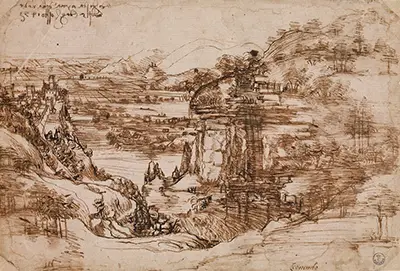This unique status makes the drawing one of the few early pieces that art historians have concrete details on and it has therefore become a popular piece for study as well as a fascinating example of the Renaissance artist's early work.
The drawing depicts Montelupo Castle and the heart of the Arno Valley, an area where Da Vinci spent a great deal of time during his formative years and may have played a great role in his personal development into an artist. The landscape is detailed and beautiful depicted, with a particular emphasis on flora and fauna.
Unlike some of Da Vinci's other works, particularly those which were painted directly onto walls and other surfaces, the drawing is dated. The timestamp shows that it was completed on 5 August 1473. Da Vinci would have been 21 years old at this time and coming to the end of his apprenticeship with the Florentine artist Andrea di Cione, also known as Verrocchio.
The drawing was produced in the final days of an apprenticeship which had run for over 7 years. Within months of completing this drawing, Da Vinci had left Verrocchio's employment and struck out on his own.
The pen and ink lines of the drawing sit on top of an erased pencil sketch. The most immediately striking thing about the drawing, compared to those by other artists of the same time period, is the total absence of people or activity. The landscape is bare and still yet still entrancing.
Almost all known paintings, sketches and other artworks produced up until this point were either portraits or still life scenes. It would be another 200 years before the first known landscape painting was produced in the 17th Century.
The ink strokes of the drawing are confident and relatively fluid, showing Da Vinci had a skilled and experienced hand at his relatively young age of 21.
Leonardo's understanding of perspective is also clear, the ink lines become fainter and the detail sketchier as detail recedes into the background of the drawing. This combination of techniques mean that the drawing sits comfortably along much more recent works by other artists - truly showing Da Vinci to be an artist who was significantly ahead of its time.
Landscape Drawing for Santa Maria Della Neve remains on public display to this day at Florence's Uffizi gallery as part of the permanent collection.
It's status as one of Leonardo Da Vinci's earliest known works has made it one of the most popular and valued items in the gallery's collection. While it doesn't draw the same crowds as the Mona Lisa in Paris, it remains a draw for visitors to the collection.


